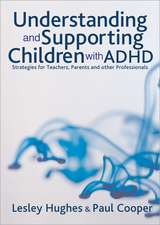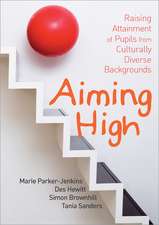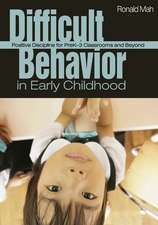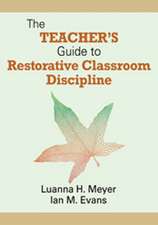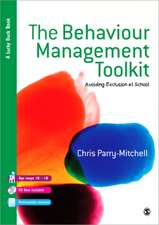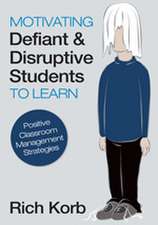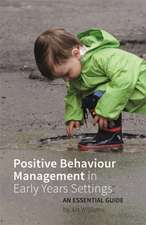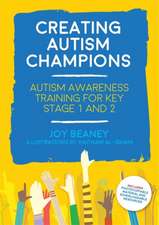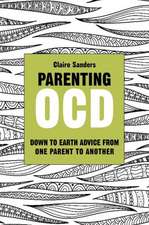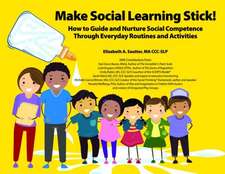You Can’t Teach Until Everyone Is Listening: Six Simple Steps to Preventing Disorder, Disruption, and General Mayhem
Autor Marilyn L. Pageen Limba Engleză Paperback – 25 iun 2008
This concise guide shows teachers how to prevent misbehaviors—rather than react to them—and emphasizes the importance of:
- Establishing your role as a proactive classroom facilitator
- Creating a safe environment for learning
- Establishing a relationship of trust with your students
You Can't Teach Until Everyone is Listening is meant to strengthen every teacher's confidence and effectiveness in creating positive and productive classrooms and helping students to grow and learn to their greatest potential.
| Toate formatele și edițiile | Preț | Express |
|---|---|---|
| Paperback (1) | 217.29 lei 6-8 săpt. | |
| SAGE Publications – 25 iun 2008 | 217.29 lei 6-8 săpt. | |
| Hardback (1) | 435.81 lei 6-8 săpt. | |
| SAGE Publications – 25 iun 2008 | 435.81 lei 6-8 săpt. |
Preț: 217.29 lei
Nou
41.58€ • 43.08$ • 34.70£
Carte tipărită la comandă
Livrare economică 21 martie-04 aprilie
Specificații
ISBN-10: 1412960150
Pagini: 168
Dimensiuni: 152 x 229 x 10 mm
Greutate: 0.28 kg
Ediția:New.
Editura: SAGE Publications
Colecția Corwin
Locul publicării:Thousand Oaks, United States
Recenzii
"Management isn't magic—it can be mastered. Page's commonsense strategies are sound in practice and needed by teachers in the field."
"Discusses the practical and easy steps to classroom discipline. This wonderful book distills much of what I spend time trying to teach the new teachers I mentor."
"Covers the fundamentals sometimes overlooked or learned the hard way. Although it is great for student teachers and mentoring of beginning teachers, it is also appropriate for seasoned teachers."
"A lot of books about classroom management exist, but many of those just offer utopian solutions that do not work in real classrooms. This book provides very solid examples and detailed practices that will not only inspire and prepare new teachers, but also help veteran teachers increase their effectiveness. A must-have reference for all teachers.”
"Page is a breath of fresh air, reminding us that the soul of teaching is working with kids. This handbook provides a perfect blend of practical advice, research, modeling, and examples to rethink what happens and what needs to happen in classrooms."
"Offers six steps for more effecitve classroom management and comes from a teacher who uses years of research and experience to support the presentation of these steps. From establishing a foundation as a classroom leader to building student trust and encouraging cooperative behavior patterns, this book is a top pick."
Cuprins
Preface
Acknowledgments
About the Author
Introduction
1. The Critical Beginning: Knowing and Using Students' Names
Barry
Knowing and Using Students' Names
Your Number 1 Classroom Management Tool
Student Teachers and Interns
Novice and Experienced Elementary Teachers
An Easy Strategy
Other Approaches
Back to Barry
Summary: Step 1
What Comes Next?
2. Avoiding Anonymous and Dangling Questions
Dave
Types of Questions Teachers Ask
Levels of Questions Teachers Ask
Dangling Questions: What Are They and What Was Dave Doing Wrong?
Students Left in the Dark
Worse Consequences
What Can You Do?
The Problems With Hand Raising
A Better Way
An Old Teacher's (or Is It Researcher's) Tale
The Results of These Better Strategies
Anonymous Questions: What Are They?
What's Wrong With These Questions?
How Can a Teacher Fix This?
Did Dave Recover?
The Experiment
The Results
Summary: Step 2
What's Next?
3. Choosing and Using Words Wisely
Mariah
Mariah's Goal
What's in a Word?
The Importance of Tight and Professional Language
What Are Filler Words?
What Happens When You Use Filler Words?
An Unprofessional Word
Mariah's Transformation
Terry
And Danae
Using Words of Civility in the Classroom
The Common Thread
Three Other Powerful Hints About Language
Making These Language and Tone Changes in Your Classroom
Summary: Step 3
Coming Attractions
4. Avoiding Confusion When Giving Directions
Elizabeth
Clarifying Directions
The Results
A Pilot Project: A Different Story
Chris
What Are We Supposed to Do?
Giving Instructions That Don't Lead to Disruption
Why It's Important for Students to Re-explain
Back Up! We Are Missing Two Preliminary Steps
Chris' Plan
The Results
Summary: Step 4
What's Next?
5. Attending to Civility With Reminders and Cues
Seventh Period: A Special Ninth-Grade Class
The First Day of School
What Happened With This Class?
Mrs. Watkins' Advice
The Problem With Classroom Rules
Simple Expectations of Civility
Jeannie
Reminders and Cues
How Often Do You Have to Give Reminders or Cues?
Jeannie's Approach
The Results
The Bottom Line
Summary: Step 5
Coming Next
6. Upgrading Interactions: Can You Feel the Heartbeat?
The Title
Julia
Moving to a Higher Level
Challenging Julia
The Results
Two Challenges for You
How to Begin
What Can Go Wrong Here?
Subtle Classroom Disorder
Jake
Shy Students
Detached Students
National History Day
Phil
The Contest
The Points of This Story
The Results
The Ultimate Goal
Summary: Step 6
Now What?
7. Harry and Clara Reclaim Their Classes
Harry
Harry's Mistake: An Ultimatum
Harry's Meltdown and Recovery
The Letter
The Students' Responses
The Results
Streamlining Harry's Format
Clara
Clara's Approach
The Results
A Bonus: You Learn More Than You Think From Student Letters or Student Drawings
Your Turn
8. Making This Happen
Beginning
Teacher Preparation Courses and Preservice Teachers
University Professors
Student Teachers
Novice Teachers
Experienced Teachers
Bon Voyage
Appendix: Handling Unwanted and Inappropriate Responses
Examples
References
Index
Notă biografică
Marilyn Page is author (with Bruce Marlowe) of Creating and Sustaining the Constructivist Classroom (Corwin Press, 1998, 2005) and Creating the constructivist classroom, a six part video series for grades K-12 (The Video Journal of Education, 1999). She began her career in education as a high school social studies and Spanish teacher and has taught in every grade 7 through 12, at every academic level, in rural, suburban, and urban school systems in different parts of the United States. She has taught at the university level and worked with pre- and in-service teachers, grades K-12, for 20 years. She also directed a major and complex research project for the development of K-12 professional certification requirements in the State of Washington. In addition to full time university teaching responsibilities, she has been the technology coordinator for education programs at two universities and developed the first Middle School Teacher Preparation programs in the Vermont State College System. She earned her EdD from the University of Massachusetts in Amherst in Instructional Leadership and in Educational Media and Instructional Technology. She consults on novice teacher, reform, classroom management, and technology issues in education. She lives in State College, Pennsylvania.



